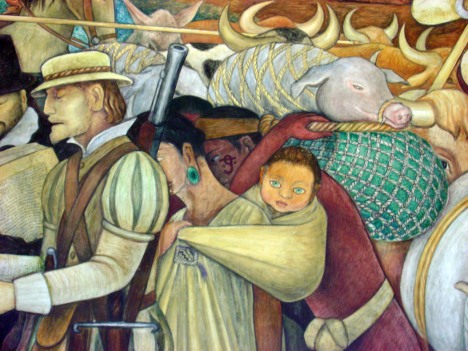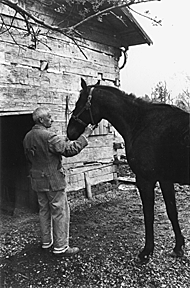 (Note: This post, crossposted here, is part of a larger interest of mine in identifying the characteristics of visual and textual rhetorics of interracial mixing and seeing what larger conclusions we can draw from those characteristics.)
(Note: This post, crossposted here, is part of a larger interest of mine in identifying the characteristics of visual and textual rhetorics of interracial mixing and seeing what larger conclusions we can draw from those characteristics.)
Ilona Katzew, Casta Painting: Images of Race in Eighteenth-Century Mexico (Yale, 2004). Amazon link here. Image found here.
Posts both at my other blog and at this one on the genre of casta painting continue to draw a fair amount of traffic, so as a follow-up to those posts I thought I would post some brief comments on Katzew’s book and offer up not so much a reading of a painting as a kind of wading-into of the various social codes casta paintings participated in.
Here are some things I hadn’t know before reading this book that seem to me of significance: First of all, casta paintings are apparently exclusively a Spanish colonial–more precisely Mexican–genre (though Katzew notes the existence of one known casta painting set from Peru). This was surprising to me because the French Caribbean colonies likewise had worked out elaborate nomenclatures for various racial combinations–though theirs involved black-white combinations, and the New Spain system carried within it an implicit didactic element for its audience, about which more later. The other thing I didn’t know was the extent of these paintings’ popularity: Katzew notes that there are 100 known complete sets of these paintings (a set usually consists of 16 paintings; some depict up to 19 racial combinations) and any number of paintings belonging to now-incomplete sets. The other sign of their popularity is that, similar to but stricter than the guild system for painters in Dutch and Flemish culture, the Spanish crown regulated the licensing of artist workshops and who could paint what subjects in the colonies. Specifically, the Crown determined through examination who could paint religious and royal subjects and how to paint them, but no such regulations governed casta paintings; Katzew politely suggests that this lack of regulation accounts for these paintings’ “wide range of quality” (9).
If you have more than passing (no pun, about which more later) interest in this subject, look for this book. Katzew’s book is exemplary art history, with the emphasis here on the “history” part. But though there is lots of history, it serves to provide much-needed context for what would otherwise be rather enigmatic paintings. But neither does it skimp on images: there are 265 of them, most of them in color, not counting large closeups of some of the paintings. Moreover, many of the paintings included here are held privately and published here for the first time, thus adding to the book’s value.
Reading Katzew’s book reassured me that for the most part I hadn’t just been talking through my hat in those earlier posts regarding these paintings’ ambiguities for their audiences. Because her book is a work of art history, as opposed to criticism, she does not in the end argue for a definitive way to think about them. Rather, by so firmly establishing their cultural and social and legal contexts, Katzew makes clear that a far safer way for us to think about these paintings is that how they were understood in the 18th century depended on a whole complex of issues. They are part American exotica for primarily Spanish consumption, part visual codification of class and racial codes (and, thus, reassurance for Spaniards that everything is under control) . . . and yet, something about the very necessity to create a casta system in the first place would lead to its eventual (partial) deconstruction in the form of the wars for independence in the first quarter of the 19th century. The title of Katzew’s conclusion pretty much sums it up: “A genre with many meanings.” It’s outside the scope of her book to do so, but I would push that conclusion harder: Given that these series of paintings are intended to be part dictionary of racial types, part social code, and part visual cabinet of curiosities, I tend to think that their audiences, if they thought about the correspondences between the paintings and the realities of New Spain, could not escape the uneasy feeling that a social order founded on racial difference would eventually become untenable–especially given that part of these paintings’ very point (and whether this point was intended or not is difficult to determine) is that those differences were becoming ever harder to discern in real life. These paintings end up implicitly depicting their own inadequacy to depict the very thing they’re intended to depict–another version of something I was trying to get at in this post with regard to American literature.
Imagine if the King of Ambiguity in American literature, Nathaniel Hawthorne, had instead been a painter in 18th-century colonial Mexico. I think you’d have a pretty good sense of the complexities casta paintings presented for their immediate audiences–and, for that matter, for us.
An example of what I mean is below the fold.
Continue reading →
Filed under: art, casta paintings, Colonial era, Latin America, mestizaje, mestizo, miscegenation, mulattoes, painting | 3 Comments »
 Lillian Smith. Image found here; Wikipedia entry here.
Lillian Smith. Image found here; Wikipedia entry here.


 Detail from a panel of Diego Rivera’s mural at the Palacio Nacional, Mexico City. Click to enlarge. Photograph by the Mrs.
Detail from a panel of Diego Rivera’s mural at the Palacio Nacional, Mexico City. Click to enlarge. Photograph by the Mrs.

 De Español y Negra, Mulato. Image found
De Español y Negra, Mulato. Image found 